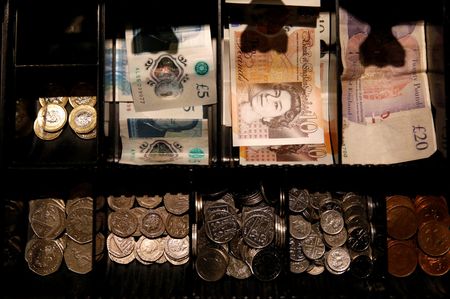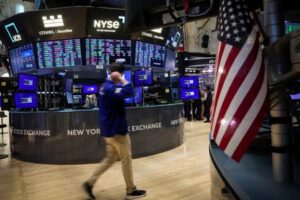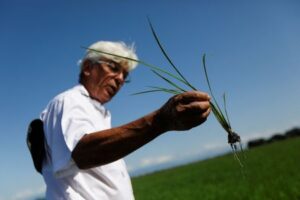By Amanda Cooper and Dhara Ranasinghe
LONDON (Reuters) -The pound hit its highest in a year on Wednesday, driven by investors who are scrambling for juicier returns as global interest rates start to fall, but strategists say it will take more than higher rates for sterling to retain that sparkle.
Data on Wednesday showed UK inflation is proving more stubborn than many expected, prompting traders to axe their bets on an August rate cut and sending the pound above $1.30 for the first time since last July.
Unlike the euro and even the dollar, the pound has not been shaken by domestic politics, but rather has got a boost from a new government that many hope will be able to draw a line under years of unpredictable policies and volatile UK markets.
Growth in Britain has also started to improve. On Tuesday, the International Monetary Fund raised its estimate of UK economic growth to 0.7% this year, from 0.5% in its last set of global forecasts in April.
But at the heart of this latest leg higher in the pound is the belief that British interest rates will take longer to decline than those elsewhere.
Many big central banks have started cutting rates. The Bank of England and the U.S. Federal Reserve are among the last dominoes standing, although the most recent signals from the latter are that September is crystallising as the starting point for U.S. rates to fall.
“It really depends on what you think is driving the pound — is it BoE rate cut expectations being pushed back or Fed rate cut expectations being pushed forward?” Geoff Yu, senior macro strategist at BNY Mellon, said.
“The fact that cable is above $1.30 and sterling has risen against the euro suggests there has been a re-pricing.”
On Wednesday, Britain’s King Charles set out Prime Minister Keir Starmer’s plans to revive the economy, with a focus on delivering new homes and infrastructure projects.
RALLIES EVERYWHERE
The rally in sterling has been broad, driving the euro, which fell 0.1% to 83.93 pence, on Wednesday, to its lowest in two years.
The pound is up 2.3% this year against the dollar, comfortably in pole position among major currencies, the runner-up – the euro – is still down 1%.
On a trade-weighted basis, the pound has recovered all of the losses incurred since the Brexit referendum in late June 2016.
So on paper, the backdrop is looking more favourable.
One major issue is Britain’s fiscal situation. UK public debt is expected to exceed 100% of gross domestic product and the government has little room to raise taxes or cut spending.
“We are in the most rate-sensitive market I can remember, and the latest UK CPI numbers do not encourage hopes for an August rate cut,” Kit Juckes, head of FX Strategy at Societe Generale, said.
“I don’t think sterling is going very far as the economy does not have that much legs, but there’s so much uncertainty in the world that there is stability with a new government (and that’s helped (the pound),” he said.
A hung parliament in France and political upheaval in the U.S. presidential race, with the attempted assassination of Republican candidate Donald Trump and the doubts around the ability of incumbent President Joe Biden to serve another four years in office, have added to the jitters across global markets.
The BoE meets on Aug. 1 and traders are attaching less than a 40% chance of a rate cut, compared with around 50% on Tuesday.
UK rates are projected to end this year around 4.75%, down from 5.25%, above U.S. rates, which are seen in a 4.50-4.75% range, and euro zone rates, priced at roughly 3.30%.
Higher UK rates mean investors can enjoy higher returns on UK assets than they would in another jurisdiction, which is helping cement the pound’s position as top dog – for now at least.
“Despite the opportunities, we still find it difficult to forecast a more significant strengthening of the pound,” Commerzbank strategist Michael Pfister said, citing uncertainty over the government’s ability to really turn things around for the economy and the possibility the BoE might take a less cautious approach to rate cuts.
“Given these risks, we expect the pound to strengthen only slightly. However, if it becomes clearer that these risks are less likely to materialise, the pound should benefit (even more),” he said.
(Additional reporting by Alun John; Editing by Sharon Singleton)





